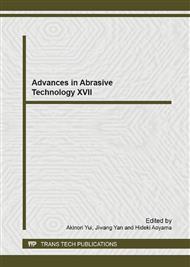p.267
p.273
p.281
p.287
p.292
p.298
p.304
p.310
p.319
Distribution of the Convection Heat Transfer Coefficients of Grinding Fluids along the Contact Zone in High Speed Grinding
Abstract:
The local distribution of the convection heat transfer coefficient (CHTC) of grinding fluids along the wheel-work contact zone under high speed grinding conditions has been investigated. A new approach has been proposed to derive the distribution of CHTCs along the contact zone by using the measured grinding temperatures and linking the distribution of local heat flux and heat partitioning to the workpiece, wheel and grinding chips. It has been found that the worktable speed is the key factor affecting the pattern of CHTC distribution, whilst the grinding speed strongly affects the overall magnitudes of the CHTCs. Down grinding mode is beneficial for achieving effective cooling under creep-feed conditions. The distribution of CHTC under faster worktable speeds shows a rather different pattern, which has to be considered when selecting the grinding mode and grinding fluid supply strategy.Keywords: Grinding, Fluid, Convective heat transfer coefficients, Temperature, High speed
Info:
Periodical:
Pages:
292-297
Citation:
Online since:
September 2014
Authors:
Keywords:
Price:
Сopyright:
© 2014 Trans Tech Publications Ltd. All Rights Reserved
Share:
Citation:


